Korean cuisine: Difference between revisions
| Line 235: | Line 235: | ||
Restaurants run by the North Korean government have opened in [[China]], [[Mongolia]], [[Cambodia]], [[Thailand]], and [[Vietnam]]. |
Restaurants run by the North Korean government have opened in [[China]], [[Mongolia]], [[Cambodia]], [[Thailand]], and [[Vietnam]]. |
||
==Consumption of dog meat== |
|||
[[Image:Gaegogi-01.jpg|thumb|A dish made with [[dog meat]] in South Korea]]<!--Need actual name of dish. Was this taken in a restaurant?--> |
|||
The consumption of [[dog meat]] is a traditional part of Korean cuisine and [[Traditional Korean medicine|medicine]]. Dog is most commonly consumed in a dish called ''[[bosintang]]'' (spicy dog stew) and in the medicinal extract ''gaeju'' (개주), also called ''gaesoju'' (개소주).<ref name="gaesoju">[http://www.gospelfarm.co.kr/imgData/hang_big.jpg Photo]</ref> Dog meat is believed to replenish energy lost to summer heat, and to enhance male sexual stamina.<ref name="salon">Salon [http://www.salon.com/wlust/feature/1998/10/28feature.html Man Bites Dog]</ref><ref name="NAM">New American Media [http://news.newamericamedia.org/news/view_article.html?article_id=f2673dc4772c709a1955accdf1bba5b5&from=rss How Much Is that Doggy on the Menu?]</ref><ref name="ST-best-friend">Seoul Times [http://theseoultimes.com/ST/?url=/ST/db/read.php?idx=3165 Korea Should Stop Eating Man's Best Friends]</ref><ref name="ST-dogs-adored">Seoul Times [http://theseoultimes.com/ST/?url=/ST/db/read.php?idx=113 Dogs Adored While Being Eaten in Seoul]</ref> Roughly 2 million dogs are eaten each year in South Korea, or an average of 1.4 kg per person.<ref name="ST-discarded">Seoul Times [http://theseoultimes.com/ST/?url=/ST/db/read.php?idx=5418 14,075 Dogs, Animals Discarded in Seoul in 2006]</ref><ref name="chosun-protest">The Chosun Ilbo [http://english.chosun.com/w21data/html/news/200008/200008240245.html Animal Rights Activists Protest Dog Eating]</ref> |
|||
Sometimes the dogs killed for consumption are first tortured, in order to increase the "fight" or [[Epinephrine|adrenaline]] in the meat. A dog that dies painfully is believed to have softer meat, and impart the energy of its death to the consumer. Methods of inflicting painful death include slow hanging and beating.<ref name="BBC-torch">BBC News [http://news.bbc.co.uk/2/hi/294627.stm Dogs blow-torched alive]</ref><ref name="KAPS">Korean Animal Protection Society [http://choimimi.com/zboarde/view.php?id=board&no=13&PHPSESSID=33548457bd044759ff16e9c297fc45b3 Video of Dog Markets and Dog slaughter from SBS News Seven]</ref><ref name="IAKA-vids">International Aid for Korean Animals [http://www.koreananimals.org/media/videoclips.htm Video Clips]</ref><ref name="IDA-vid">In Defense of Animals, video from Animal Freedom Korea. [http://www.idausa.org/campaigns/korea/alert_070829.html Undercover Video]</ref><ref name="ST-best-friend"/><ref name="chosun-protest"/> The ''nureongee''<!--Shouldn't we use the Revised romanization?--> (누렁이) breed is commercially raised for consumption<ref name="gaesoju"/>, though a number of other breeds have also been sold for food, including some commonly considered as pets.<ref name="BBC-torch"/> |
|||
Consumption of dog meat became controversial in South Korea as a result of the [[1988 Summer Olympics]] and [[2002 FIFA World Cup]] in Seoul. The government banned the sale of dog meat prior to the Olympics, under international pressure. However, the law is not strictly enforced.<ref>CNN/World [http://archives.cnn.com/2001/WORLD/asiapcf/east/11/06/fifa.skorea/index.html FIFA barks at Korean 'animal cruelty']</ref><ref name="ST-dogs-adored"/><ref name="salon"/> Some online petitions opposed to dog consumption in Korea have gathered thousands of signatures.<ref>[http://www.gopetition.com/petitions/ban-dog-meat-and-cat-soup-in-korea/signatures.html Ban dog meat and cat soup in Korea]</ref> |
|||
== See also == |
== See also == |
||
Revision as of 01:39, 27 March 2008
This article needs additional citations for verification. (August 2007) |

Korean cuisine is based on the traditional foods and preparation techniques of Korea. From the complex Korean royal court cuisine to regional specialties and modern fusion cuisine, their ingredients and preparation are richly varied. Many dishes are becoming internationally popular. The foods described in this article are very different from Korean royal court cuisine, which is, to this day, widely enjoyed by the Korean masses.
Korean cuisine is largely based on rice, noodles, tofu, vegetables, and meats. Traditional Korean meals are noted for the number of side dishes (banchan) that accompany the ubiquitous steam-cooked short-grain rice and soup. Every meal is accompanied by numerous banchan.[1]
Kimchi is a fermented, spicy vegetable dish usually made of baechu, radish, or cucumber. At least one type of kimchi is served as banchan at virtually every meal, year-round. It is also a common ingredient in other Korean recipes.
Korean food is usually seasoned with sesame oil, doenjang (fermented soybean paste), soy sauce, salt, garlic, ginger and gochujang (red chili paste). Korea is the largest consumer of garlic, ahead of the rest of Asia (particularly China and Thailand, excluding Japan) and the Northern Mediterranean (mainly Spain, Italy, and Greece).
Korean cuisine varies seasonally. During winter, traditional food usually relies on kimchi and other pickled vegetables preserved in big ceramic containers stored underground in outdoor courtyards. Preparation of Korean food is generally very labor-intensive.
Korean royal cuisine, once only enjoyed by the royal court of the Joseon period, takes hours to days to prepare. It must harmonize contrasting characteristics such as warm and cold, hot and mild, rough and soft, solid and liquid, and a balance of presentation colors. It is often served on hand-forged bronzeware or bangjjaa. The foods are served in a specific arrangement of small dishes alternating to highlight the shape and color of the ingredients.
Some of these traditional royal cuisines, which can cost as much as ₩240,000 (~US$265) per person excluding drinks, include service by exclusive waiters. Restaurants that serve traditional royal cuisine can be found in select locations within the city of Seoul. Imperial cuisine has received a recent boost in popularity due to Dae Jang Geum, a widespread, popular Korean television drama about a humble girl becoming the royal head chef during the Joseon period. There is also a Korean tea ceremony.
Korean table settings
Koreans traditionally ate (and many still do eat) seated on cushions at low tables with their legs crossed in a modified lotus position. Some traditional restaurants provide floorchairs with backs.
Meals are eaten with a set of silver or stainless steel chopsticks called jeotgarak and a long-handled shallow spoon called sutgarak (similar to the Western spoon, unlike the Chinese soup spoon); the two are together known as sujeo (a contraction of sutgarak and jeotgarak), although sujeo can also mean a sutgarak. Unlike other chopstick cultures, Koreans have used spoons since at least the 5th century.
Unlike the Chinese and Japanese, Koreans consider picking up rice or soup bowls to be bad manners. All bowls and dishes should be left on the table and rice and soups should be eaten with the spoon. However, some leeway may be allowed in casual dining situations. Banchan are eaten with chopsticks.
A typical table setting consists of:
- rice for each person in a small silver or stainless steel bowl that is taller than its diameter with a cover placed directly in front of the diner
- hot soup for each person in a larger bowl that is wider than its height or sometimes jjigae or other liquid foods shared from a large pot in the center of the table.
- a set of silver (traditional) or stainless steel spoon for rice and soup, and chopsticks for banchan
- various small bowls of shared banchan side dishes
- Depending on the household, drinks may or may not be served while eating though usually water, tea (sometimes a grain tea such as barley tea may be served, rather than fragrant teas such as herbal or floral enhanced teas as many believe their taste does not match well with rice and the savory banchan) is served with the meal. Alcohol is the other main drink that typically accompanies a traditional Korean meal. After the meal, a sweet refresher like soojunggwa or shikye might be taken. Different drinks might be served depending on the time of year.
Traditional Korean table etiquette
This article's tone or style may not reflect the encyclopedic tone used on Wikipedia. (December 2007) |
Although there is no prescribed order for eating the many banchan (side dishes), rice, soup, or any miscellaneous foods on the table, it is customary to dip into one's individual rice or soup bowl, while the others taste the banchan (side dishes). Essentially, the elders, superiors, and/or guests must be treated with respect and have the privilege of eating first. It is also common that the best dishes are reserved for the elders, superiors, and guests.
Koreans do not pick up their rice or soup bowls from the table. Etiquette requires that the bowls stay on the table and that the sutgarak(spoon) and jeotggarak(chopsticks) are used to bring food to the mouth. Although picking up the bowls with one's hands is seen as uncouth, it may be socially acceptable in casual settings. Traditionally, the yangban class had the privilege of eating from lacquered tables as opposed to peasants who were relegated to meals in the field.
Bad manners include:
- not finishing all of one's rice
- declining when food or drink is offered by an elder
- picking up chopsticks or a spoon and eating before the oldest person at the table does
- sticking the chopsticks or spoon straight up in the bowl as it's reminiscent of incense burned during a funeral
- stabbing foods with chopsticks and picking up food with hands (there are some finger foods, but a shared banchan dish at a table is usually not considered a finger food)
- using a spoon and chopsticks at the same time, holding them together in one hand
- making unnecessarily noisy sounds when chewing foods or clanking a bowl with a spoon or chopsticks
- stirring rice or soup with a spoon or chopsticks
- stirring shared side dishes to select what you want to eat
- removing certain spices or ingredients from shared side dishes
- finishing eating much faster or slower than the others at the same table
- using toothpicks with the mouth open and leaving them on the table
- drinking alcohol while looking straight at an elder; one must must turn away a little to the side and tilt one's head
- accepting a drink from an elder or superior with both hands on the cup (Instead, the left hand is usually placed on the elbow of the right hand which holds the cup).
In informal situations, these rules are not important. During family dinners, however, they are usually enforced for the benefit of the children, so that they learn proper table manners and etiquette. The rules are enforced less frequently as children become older and have fully learned table manners relevant to Korea.
Speaking with food in one's mouth is acceptable, as long as one's mouth remains closed. Because one of the Korean equivalents of "Yeah" is "Mm", it is acceptable to answer someone's query with a closed mouth in a variety of ways. However, it is considered rude to reply with one's mouth open or with food showing. Chewing with one's mouth open in an overtly disgusting manner is also considered bad manners. It is considered perfectly acceptable to slurp one's soup. This is because the soups that Koreans serve are often served at boiling temperatures, and thus you must slurp in order to prevent yourself from being scalded. Koreans will comment that a guest is very quiet during dinner if he or she does not speak, and one will not keep pace in eating with the Koreans if one stops eating to speak.
Another rule to remember is that older people and higher ranked people (by profession or social status) often do not have to follow the rules, and that other people at the table do have to follow the rules; the point of these rules is to show due respect to those who are above you.
Though diners do not need to finish all the shared food that was provided, it is customary to finish one's individual portion of rice. Eating too quickly will imply that insufficient food was given. Therefore, it is rude to eat too quickly and finish long before the others at the table. It is also rude to leave excessive amounts of leftover food because it is seen as wasteful. This is especially important at someone else's home or when eating with elders, who may comment about the past, rice was too expensive to be eaten commonly. At restaurants, Koreans tend to have one person pay for the entire meal. Unlike in Western countries where people pay "Dutch" by dividing up the bill, one person offers to pay and others repay the person by paying for a meal in the future. Banchan dishes are intended to be finished at each meal, so they are presented in small portions and replenished as they are emptied. It is acceptable to ask for refills of any of the side dishes.
Korean foods and dishes
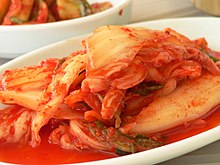
Much of Korean cuisine consists of simple dishes. Many Korean banchans rely on fermentation for flavor and preservation, resulting in a tangy, salty, and spicy taste.
Certain regions are especially associated with some dishes (for example, the city of Jeonju with Bibimbap) either as a place of origin or for a famous regional variety. Restaurants will often use these famous names on their signs or menus (i.e. "Suwon galbi").
Romanization of Korean words may vary widely, with g/k (eg galbi/kalbi), j/ch, d/t and b/p often used interchangeably.
Main meat dishes
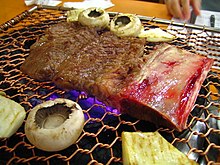

At traditional restaurants, meats are cooked at the center of the table over a charcoal grill, surrounded by various banchan and individual rice bowls. The cooked meat is then cut into small pieces and wrapped with fresh lettuce leaves, with rice, thinly sliced garlic, ssamjang (a mixture of gochujang and dwenjang), and other seasonings.
- Bulgogi (불고기): thinly sliced or shredded beef marinated in soy sauce, sesame oil, garlic, sugar, green onions and black pepper, cooked on a grill (sometimes at the table). Bulgogi literally means "fire meat". Variations include pork (Dweji bulgogi), chicken (Dak bulgogi), or squid (Ojingeo bulgogi).
- Galbi (갈비): pork or beef ribs, cooked on a metal plate over charcoal in the centre of the table. The meat is sliced thicker than bulgogi. It is often called "Korean BBQ", and can be seasoned or unseasoned. A variation using seasoned chicken is called (Dakgalbi).
- Jokbal (족발): pig's feet served with a red salted shrimp sauce.
- Samgyeopsal (삼겹살): Unseasoned pork bacon cut from the belly, served in the same fashion as galbi. Sometimes cooked on a grill with kimchee troughs at either side. Commonly grilled with garlic and onions, dipped in ssamjjang and wrapped in lettuce leaves.
- Hoe(Pronounced 'hweh') \hö\ (회): raw seafood dish dipped in gochujang or soy sauce with wasabi, served with lettuce or sesame leaves.
- Sannakji (산낙지) or live octopus. Sannakji is served live and still moving on the plate.
- Makchang (막창): grilled pork large intestines prepared like samgyeopsal and galbi. Often served with a light doenjang sauce and chopped green onions. Very popular in Daegu and the surrounding Gyeongsang region.
- Gobchang (곱창): similar to makchang except prepared from the small intestines of pork (or ox).
-
Galbi sal (갈비살, boneless galbi)
-
Sogalbi (소갈비 beef galbi)
-
Dwaeji galbi (돼지갈비 pork galbi)
-
Dak galbi (닭갈비 chicken galbi)
-
Bulgogi (불고기 Bulgogi)
-
Samgyeopsal (삼겹살 Samgyeopsal)
Royal dishes
- Gujeolpan (구절판): literally "nine-sectioned plate", this very elaborate dish consists of a number of different vegetables and meats served with thin pancakes. It is served only at special occasions such as weddings, and is associated with royalty.
- Sinseollo (신선로): An elaborate dish of meat and vegetables cooked in a rich broth. It is served in a large silver vessel with a hole in the center, where hot embers are placed to keep the dish hot throughout the meal.
Soups and stews

- Doenjang jjigae (된장찌개): or soybean paste soup, is typically served as the main course or served alongside a meat course. It contains a variety of vegetables, shellfish, tofu, and occasionally small mussels, shrimp and/or large anchovies. Usually, anchovies are used for preparing base stock, and are put out before adding main materials.
- Cheonggukjang jjigae (청국장찌개): a soup made from strong-smelling thick soybean paste
- Gamjatang (감자탕, "potato stew"): a spicy soup with pork spine, vegetables (especially potatoes, 감자) and hot peppers. The vertebrae is usually separated. This is often a late night snack but is also served for a lunch or dinner.
- Haejangguk (해장국): a favorite hangover cure consisting usually of meaty pork spine, dried cabbage, coagulated ox blood (similar to blood pudding), and vegetables in a hearty beef broth. Legend has it that soon after World War II, the restaurant that invented this stew was the only place open in the Jongno district when the curfew at the time lifted at 4 a.m.
- Janchi guksu (잔치국수): a light seaweed broth based noodle soup served with fresh condiments, usually kimchi, thinly sliced egg, green onions, and cucumbers.
- Jeongol (전골) : a traditional spicy Korean stew, consisting of various types of seafood and vegetables. It is generally served on a burner.

- Kimchi jjigae (김치찌개): A soup made with mainly Kimchi, pork, and tofu. It is a common lunch meal or compliment to a meat course. It is normally served in a stone pot, still boiling when it arrives at the table.
- Maeuntang (매운탕): a refreshing, hot & spicy fish soup.
- Samgyetang (삼계탕): a soup made with Cornish Game Hens that are stuffed with ginseng, a hedysarum, sweet rice, jujubes, garlic, and chestnuts. The soup is traditionally eaten in the summer.
- Seolleongtang (설렁탕): ox leg bone soup simmered for more than 10 hours until the soup is milky-white. Usually served in a bowl containing glass noodles and pieces of beef. Sliced green onions and coarse sea salt are used as condiments.
- Sundubu jjigae (순두부 찌개): a thick spicy stew made with soft tofu. Traditionally, the diner puts a raw egg in it while it's still boiling.
- Budae jjigae (부대찌개, "army squad stew"): Soon after the Korean War, meat was scarce in Seoul. Some people made use of surplus foods from US Army bases such as hot dogs and canned ham (such as Spam) and incorporated it into a traditional spicy soup. This budae jjigae is still popular in South Korea, and the dish often incorporates more modern ingredients such as instant ramen noodles.
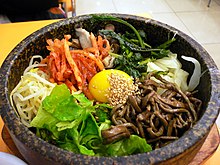
Mixed rice
- Bibimbap (비빔밥, "mixed rice"): rice topped with vegetables, beef and egg, and served with a dollop of chili pepper paste. A variation of this dish, dolsot bibimbap (돌솥 비빔밥), is served in a heated stone bowl, in which a raw egg is cooked against the sides of the bowl. Yukhoe (육회) is a popular version, comprising raw beef strips with raw egg and a dash of soy sauce mixed with Asian pear and gochujang. Everything (seasonings, rice and vegetables) is stirred together in one large bowl and eaten with a spoon.
As a representative cusine, and because of the convenience of preparation, recently Bibimbap is served as airline meal in various airlines connecting to Korea, including not only Korea-based airlines but also foreign such as Lufthansa.
- Hoedeopbap \hweh-dup-bahp\ (회덮밥): rice topped with cubed raw fish, fresh vegetables and chogochujang.
Banchan (side dishes)
- Kimchi (김치): vegetables (usually baechu, white radish, or cucumber) commonly fermented in a brine of ginger, garlic, green onion and chilli pepper. There are endless varieties, and it is served as a side dish or cooked into soups and rice dishes. Koreans traditionally make enough kimchi to last for the entire winter season, although with refrigerators and commercial bottled kimchi this practice has become less common.
- Kongnamul (콩나물): Soybean sprouts, usually eaten in boiled and seasoned banchan. Soybean sprouts are also the main ingredient in kongnamul-bap (sprouts over rice), kongnamul-guk (sprout soup), and kongnamul-gukbap (rice in sprout soup).
Noodles

- Bibim Guksu (비빔국수): Spicy cold wheat noodles. Extremely popular during summer season.
- Naengmyeon (냉면, (North Korea: 랭면, Raengmyŏn), "cold noodles"): this summer dish consists of several varieties of thin, hand-made buckwheat noodles, and is served in a large bowl with a tangy iced broth, raw julienned vegetables and fruit, and often a boiled egg and cold cooked beef. This is also called Mul ("water") Naengmyeon, to distinguish Bibim Naengmyeon, which has no broth and is mixed with gochujang.
- Japchae (잡채): Boiled sweet potato starch noodles (dangmyeon), steamed spinach, roasted julienned beef, roasted sliced onion, roasted julienned carrots are mixed with seasoning made of soy sauce, sesame oil and half-refined sugar.
- Jajangmyeon (짜장면): A variation on a Chinese noodle dish that is extremely popular in Korea. It is made with a black bean sauce, usually with some sort of meat and a variety of vegetables including zucchini and potatoes. Usually ordered and delivered, like pizza.
- Kalguksu (칼국수): boiled flat noodles, usually in a broth made of anchovies and sliced zucchini.
- Ramyeon (라면): spicy variation of Japanese Ramen, usually cooked with vegetables and meats.
Korean snacks
Snacks play an important social role in Korean culture. In Korea, snack food may be purchased from street carts during the day, where customers may eat standing beside the cart or have their food wrapped up to take home. At night, many streets are filled with small tents that sell inexpensive foods, drinks, and alcoholic beverages. Most Korean people consider the food sold there as snacks rather than a complete meal. Seasonal snacks include patbingsu, a refreshing iced treat eaten in the summer, and warm soup, kimbap, hotteok, and bungeoppang, which are enjoyed in the fall and winter.
Kimbap
Kimbap (literally, seaweed-rice, 김밥) is actually not as much a snack as much as a lunchbox meal. Mostly eaten on picnics. It was usually eaten more for ease rather than fulfillment.
It consists of cooked rice, sesame oil, salt, and sesame seeds, to which small amounts of vinegar and sugar are often added as seasonings. Then it is placed on a sheet of dried gim (laver). The seasoned rice is spread on the gim, and then fried egg, julienned carrots, julienned ham, seasoned ground beef or seasoned fish cakes, pickled daikon, seasoned spinach, and seasoned burdock root and cucumber are then placed closely together on the rice, and is rolled in the manner similar to that of the Japanese sushi. Today, there are many varieties of kimbap: tuna, cheese, bulgogi, vegetable, and more.
An appetizer that is closely related to kimbap is the California roll. This appetizer differs from kimbap because it is often made with imitation crab meat and Tobiko (caviar) is rolled onto the outside of the rice. Also, the cooked eggs are often left out. The California roll is very popular and can be easily purchased in the United States.
Buchimgae/Jeon
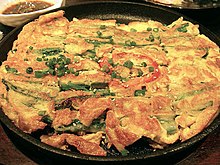
Fermented kimchi (kimchijeon) or seafood (haemul pajeon) is mixed into a flour-based batter, and then fried in an oiled pan. This dish tastes best when it is dipped in a mixture of soy sauce, vinegar, and red pepper powder.
- Pajeon (파전): pancake made mostly with eggs, flour, green onion, and oysters or fresh baby clams cooked on frying pans.
- Bindaetteok (빈대떡): pancake made of ground mung beans, green onions, and kimchi or peppers cooked on frying pans.
Bungeo-ppang/Gukwa-Ppang/Gyeran-ppang
Bungeo-ppang (붕어빵; "goldfish-bread") is a fish-shaped pastry that is usually filled with sweet red bean paste and then baked in a fish-shaped mold. It is very chewy on the inside and crispy on the outside. Gukwa-ppang (국화빵) is almost the same as bungeo-ppang, but it is shaped like a flower. Gyeran-ppang (계란빵) tastes similar to bungeo-ppang, but it has a shape of rounded rectangle. They are often sold by street vendors. (See also taiyaki.)
Other snacks

- Ddeokbokki (떡볶이): a broiled dish which is made with sliced rice cake, seasoned beef, fish cakes, and vegetables. It is flavored with gochujang
- Soondae (순대): Korean sausage made with a mixture of boiled sweet rice, oxen or pig's blood, potato noodle, mung bean sprouts, green onion and garlic stuffed in a natural casing.
- Ho-tteok (호떡) : similar to pancakes, but the syrup is in the filling rather than a condiment. Melted brown sugar, honey, chopped peanuts and cinnamon are common fillings. Vegetables are sometimes added to the batter. Hotteok is usually eaten during the winter months to "warm up" the body with the sweet and warm syrup in the pancake.

Anju (side dishes accompanying alcoholic beverages)
- Anju (안주) is a general term for a Korean side dish consumed with alcohol (often with Korean soju). It is commonly served at bars, noraebang (karaoke) establishments, and restaurants that serve alcohol. These side dishes can also be ordered as appetizers or even a main dish. Some examples of anju include steamed squid with gochujang, assorted fruit, dubu kimchi (tofu with kimchi), peanuts, odeng/ohmuk, kimbap (small or large), samgakimbap (triangle-shaped kimbap like the Japanese onigiri), sora (소라 (a kind of shellfish popular in street food tents), and nakji (small octopus, as eaten on screen in the movie Oldboy). Soondae is also a kind of anju, as is samgyeopsal, or dwejigalbi. Most Korean foods may be served as anju, depending on availability and the diner's taste. However, anju are considered different from the banchan side dishes served with a regular Korean meal.
Desserts
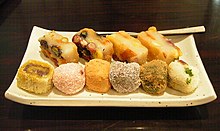
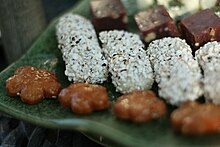
- Tteok (떡): a chewy cake (rice cakes) made from either pounded short-grained rice (메떡, metteok), pounded glutinous rice (찰떡, chaltteok), or glutinous rice left whole, without pounding (약식, yaksik). Is is served either cold (filled or covered with sweetened mung bean paste, red-bean paste, raisins, a sweetened filling made with sesame seeds, mashed red beans, sweet pumpkin, beans, dates, pinenuts and/or honey), usually served as dessert or snack. Sometimes cooked with thinly-sliced beef, onions, oyster mushrooms, etc. to be served as a light meal.
- Songpyeon (송편): chewy stuffed tteok (rice cake) served at Chuseok (Mid-Autumn Festival) decorated with pine needle. Honey or another soft sweet material, or red bean is found inside.
- Yaksik (약식) is a dessert made with sweet rice, chestnut, pine nut, jujube and raw sugar.
- Chapssaltteok (찹쌀떡): a variety of tteok filled with sweetened bean paste. Similar to Japanese Mochi
- Hahngwa (한과): general term referring to Korean traditional confectionery. The ingredients of hahngwa mainly consists of grain flour, honey, yeot, and sugar, or of fruit and edible root.
- Yugwa (유과): made by frying and kneading like the literal meaning of the term.
- Maejakgwa (매작과): ring-shaped confection made of wheat flour, vegetable oil, cinnamon, ginger juice, jocheong and pine nuts.
- Suksilgwa (숙실과)
- Gwapyeon (과편)
- Dasik (다식)
- Jeonggwa (정과)
- Yeot gangjeong (엿강정)
- Yeot (엿): a Korean traditional candy in liquid or solid. Yeot is made from steamed normal rice, glutinous rice, glutinous kaoliang, corn, sweet potatoes or mixed grains. The steamed ingredients are lightly fermented and boiled in a big pot (sot 솥) for a long time.
- Yugwa (유과): made by frying and kneading like the literal meaning of the term.
Korean beverages
Non-alcoholic beverages

- Insam cha (인삼차) - Korean ginseng tea
- Saenggang cha (생강차) - Tea made from ginger root.
- Sujeonggwa (수정과) - dried persimmon punch
- Sikhye (식혜) - sweet rice beverage
- Yujacha (유자차) - citron tea
- Bori cha (보리차) - roasted barley tea
- Oksusu cha (옥수수차) - roasted corn tea
- Hyeonmi cha (현미차) - roasted brown rice tea
- Sungnyung (숭늉) - beverage made from boiled scorched rice
Alcoholic beverages
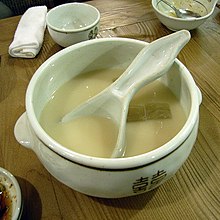
While soju (소주) is the best known liquor, there are well over 100 different beers, wines and liquors available in Korea. The top-selling domestic beers are lagers, similar to others found in Europe and Asia. These include:
- Cass
- Hite, Hite Prime, Hite Prime Max
- Cafri
- OB lager beer which adds rice to the grain base, and is also available as a dry beer.
- Taedonggang (대동강) is a North Korean beer which is now sold bottled in some bars in South Korea.
- Microbrewery beers and bars are growing in popularity.
Soju is a clear spirit which was originally made from grain, and is now also made from sweet potatoes. Soju made from grain is considered superior (as is also the case with grain vs. potato vodka). Soju is around 22% ABV and is a favorite beverage of hard-up college students, hard-drinking businessmen, and blue-collar workers.
Yakju is a refined pure liquor fermented from rice, with the best known being cheongju. Takju is a thick unrefined liquor made with grains, with the best known being makkoli (막걸리), a white, milky rice wine traditionally drunk by farmers.
Korean wines are generally divided into fruit wines, and herbal wines. Acacia, maesil plum, Chinese quince, cherry, pine fruits, and pomegranate are most popular. Majuang wine (a blended wine of Korean grapes with French or American wines) and ginseng-based wines are also available.
Juansang - Alcoholic drinks (ju) and accompanying side dishes (an) are set on the table. The dishes vary depending on the kinds of liquor or wine.
Gyojasang is a large table prepared for banquets. Alcohol beverages and a large variety of side dishes, rice cakes, confectionaries, and fruit punch are all placed on the table. After the liquor is finished, noodle soup is served.
Contemporary innovations
Fusion food is also rapidly becoming popular. There are many Chinese, northern Italian, French, and Indian fusion restaurants all over South Korea.
Vegetarian restaurants, which were sidelined with the decline of Buddhism and advance of missionary Christianity, have had a small resurgence, and can usually be found in every city.
Korean restaurants abroad
Korean restaurants are usually available in areas with large Korean populations. Common examples include Koreatowns situated in other countries.
Restaurants run by the North Korean government have opened in China, Mongolia, Cambodia, Thailand, and Vietnam.
See also
Footnotes and References
- ^ Fritscher, Lisa. "Korean Food Basics: What You Might Find On A Korean Food Menu". LifeScript.com. Retrieved 2007-11-17.
{{cite web}}: More than one of|author=and|last=specified (help)
Cost, Bruce (2000). Asian ingredients: a guide to the foodstuffs of China, Japan, Korea, Thailand, and Vietnam. New York: Harper Perennial. ISBN 0-06-093204-X.
O'Brien, Betsy (1997). Let's Eat Korean Food. Elizabeth, NJ: Hollym. ISBN 1-56591-071-0.
External links
- Korean Food Photo Recipes Blog
- Korean Food Recipe and Pictures
- Official site of Korea National Tourism List of Korean Food
- ZenKimchi Korean Food Journal
- Eating the Korean way
- Korean BBQ Video Gallery


